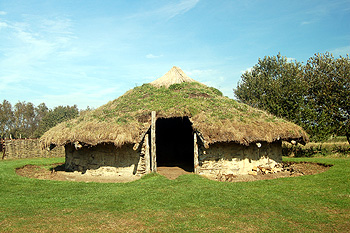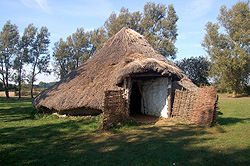Early Chalton

A reconstruction of an Bronze Age round house at Flag Fen October 2011
The Bedfordshire Historic Environment Record [HER] contains information on the county's historic buildings and landscapes and summaries of each entry can now be found online as part of the Heritage Gateway website. The earliest record of human activity in Chalton comes from the Bronze Age. Archaeological excavation unearthed a pit north-east of Houghton Park [HER 19891] which contained a small sherd of pottery dating to the late Bronze Age or early Iron Age as well as animal remains. South of Chalton Cross Farm in 2012 Albion Archaeology found a small pit containing animal remains and a sherd of pottery dating to a similar date [HER 19923]. There was also a ditch running east-west as well as a curved ditch about 6 metres across and half a metre deep when first dug, this joined a large pit, the blue-grey silty fill of which suggests that it gathered water.
In a smiliar area to the last find was a hollow, again gating to the late Bronze Age and early iron Age [HER 19924]. It was large and irregularly shaped, again with blue-grey silt infill, perhaps from Houghton Brook. A sall sherd of pottery was found. Finally, an incomplete copper alloy handle was found at Manor Farm by a metal detectorist in February 2012 [HER 19339]. It has human/animal designs on it but is undatable and may come from any period from the Bronze Age to the 19th century.
Excavations in Chalton by Northamptonshire Archaeology in 2008 revealed some isolated ditches containing animal remains and a sherd of pottery from the Iron Age [HER 18293]. A stretch of ditch aligned north-east to south-west was found by Albion Archaeology in 2012 south-west of Chalton Cross [HER 19892]. It may be a boundary date and was dated to the late Iron Age or early Romano-British period.
The Roman occupation of the area left a number of indications behind it. The Viatores are a group dedicated to trying to find Roman roads in the modern landscape. Of necessity these are often speculative and the group have suggested a Roman road [Viatores Road Number 177] running from Tilsworth through Chalgrave, Houghton Regis, Chalton and Streatley to Barton-le-Clay [HER 691]. Local analysis if this suggested road tends to disprove it as many of the roads and hedgerows used by the Viatores to chart its course are modern, not being present on 18th and 19th century inclosure maps.
An area of Romano-British occupation has been identified south-west of Chalton [HER 1438], evidenced by building debris found in field-walking and enclosures identified by aerial photography. Trial excavations in 1962 found no evidence for buildings but further excavations in 2000 found an alignment of sandstone blocks suggesting a building. Animal remains and slag from iron-working have been found in association with the site as well as charcoal, a ditch and pit.
Romano-British activity was found during construction of the Midland Railway line in 1865 [HER 6659]. Pottery was found and when the railway was widened in the 1890s a forty feet deep Roman well was discovered containing pottery and animal bones. The well was found 90 yards south of a bridge leading to lime kilns at Sundon.
North of Kestrel Way, just north of the boundary between Chalton and Luton excavations by Albion Archaeology in 2012 revealed a farmstead dating from the late Iron Age or early Romano-British period [HER 19925]. Animal remains and pottery were found in association with rectangular enclosures and ditches. There were two main enclosures one of which was lined on one side by a ditch 3.5 metres wide and over 1.2 metres deep.
North-west of the village two undated pits have been found. One contained a fragment of an iron nail which may by of Roman date, or later [HER 19941]. A ditch and pathways of definitely Roman date were identified north-east of the large electricity sub-station at Chalton [HER 19951]. Albion Archaeology found snimal remains, pottery, brick and other building materials. The pottery dated from the late Iron Age into the Roman—British era and the building remains, including brick and tile are Roman. Two pathways defined by ditches running east-north-east to west-south-west and north-north-west to south-south-east lie near the building debris.

A reconstruction of an Iron Age round house at Flag Fen October 2011